Post by Anijumper on Apr 29, 2006 15:06:21 GMT -5
Many people new to showing(or petz) get the different dogz poses confused or don't know what they are. So I'm here to explain them. There are four types, two of which are usually seen in pose shows. I'll also tell you about a fifth, which only sort of qualifies as a pose.
Dali
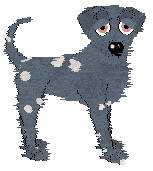
Definition of a dali: Back and front legs together, tail curled over back(if possible for the breed), eyes facing camera, eyelids slanted, the dog has a proud and relaxed look. Head is turned to the left(<<<). Nose is about in line from the paws(vertically). The head is centered, not crooked. Ears lay against head(again, if possible for the breed). Breeds with shorter muzzles, or with dali-like structure, look best in this pose.
Why Dali(Dalmatian)?
Originally this pose was meant just for the original dali breed, because the dalmatian can look kind of odd in a dane.
Dane

Definition of a Dane pose: Head facing the right(>>>). One eye showing(exceptions are made for some breeds,such as the original labrador). Eye focused on the camera. A little eyelid should be showing. Head is held level(as shown above), and occasionally a little proud. Back and front legs are together, tail curled over back(depends on breed). The dog has a proud look, and the pose looks best if the ears are not pulled back. Head is not too far away from the camera, or too close(you can see the whole nose, or beyond, for example).
Most breeds with long muzzles look best in this pose, and because this is a pose that is harder to get, a good dane pose will often place higher than a good dali.
Three-Fourths(3/4) Pose
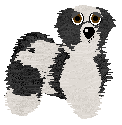
You very rarely see this type of pose in the pose ring. In most cases, it is not allowed.
Definition of a Three-Fourths Pose: The front and back legs are together and all paws are on the ground. Tail is curled over back(if possible for the breed). Ears lay close to the head(again,i f possible). The head can be in many different positions. The picture above shows one, but anywhere in between dali and dane is often considered a 3/4 pose. Any eyes showing should be focused on the camera.
Only a few breeds look really nice in this pose, not to mention, most shows don't allow this pose. I'd advise you to stay away from it unless you're showing in the PKC or other showing organization that accepts 3/4 poses.
Poodle Pose
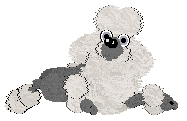
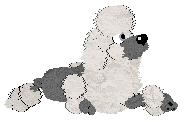
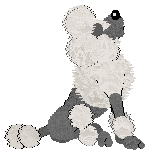
There is little information out there about the poodle pose. I'm guessing because of this, there are many variations on what is a poodle pose, and very few shows accept them.
As you can see, the first two examples are relatively similar, and might be variations on the dali and dane poses. The keys to these poses are the tail that's pointing down, and front legs that are crossed. The visible hind leg is tucked up against the body.
In the first pose, the head is facing the camera at an angle, with the eyes wide open. In the second, the head is facing to the side, although not fully, with the eye looking towards the side as well. Only one eye should be visible.
The third pose is completely different. the dog is sitting with his front legs together, tail is pointing down only slightly, the visible eye is closed, and the head is pointing straight up in the air.
The first two are the more standard forms, the one that you see the most often. These should be the types you use in shows, as judges that accept poodle poses probably will only accept these two types.
Only PF Magic Poodles pose this way, and breeds with this personality. To get them to pose like this, place a sweater on your poodle, then quickly take it off. You may have to repeat this several times. Quickly snap a picture when your dog moves into poodle pose.
German Shepherd Dog Pose aka GSD Pose
What this pose really is, is a dane or dali pose done by a german shepherd from a file that has staggered legs. Some judges accept these under dane or dali, and some specifically state "GSD" or "German Shepherd pose". If you are unsure whether a judge will accept your dog's pose, ask them.
Dali

Definition of a dali: Back and front legs together, tail curled over back(if possible for the breed), eyes facing camera, eyelids slanted, the dog has a proud and relaxed look. Head is turned to the left(<<<). Nose is about in line from the paws(vertically). The head is centered, not crooked. Ears lay against head(again, if possible for the breed). Breeds with shorter muzzles, or with dali-like structure, look best in this pose.
Why Dali(Dalmatian)?
Originally this pose was meant just for the original dali breed, because the dalmatian can look kind of odd in a dane.
Dane

Definition of a Dane pose: Head facing the right(>>>). One eye showing(exceptions are made for some breeds,such as the original labrador). Eye focused on the camera. A little eyelid should be showing. Head is held level(as shown above), and occasionally a little proud. Back and front legs are together, tail curled over back(depends on breed). The dog has a proud look, and the pose looks best if the ears are not pulled back. Head is not too far away from the camera, or too close(you can see the whole nose, or beyond, for example).
Most breeds with long muzzles look best in this pose, and because this is a pose that is harder to get, a good dane pose will often place higher than a good dali.
Three-Fourths(3/4) Pose

You very rarely see this type of pose in the pose ring. In most cases, it is not allowed.
Definition of a Three-Fourths Pose: The front and back legs are together and all paws are on the ground. Tail is curled over back(if possible for the breed). Ears lay close to the head(again,i f possible). The head can be in many different positions. The picture above shows one, but anywhere in between dali and dane is often considered a 3/4 pose. Any eyes showing should be focused on the camera.
Only a few breeds look really nice in this pose, not to mention, most shows don't allow this pose. I'd advise you to stay away from it unless you're showing in the PKC or other showing organization that accepts 3/4 poses.
Poodle Pose



There is little information out there about the poodle pose. I'm guessing because of this, there are many variations on what is a poodle pose, and very few shows accept them.
As you can see, the first two examples are relatively similar, and might be variations on the dali and dane poses. The keys to these poses are the tail that's pointing down, and front legs that are crossed. The visible hind leg is tucked up against the body.
In the first pose, the head is facing the camera at an angle, with the eyes wide open. In the second, the head is facing to the side, although not fully, with the eye looking towards the side as well. Only one eye should be visible.
The third pose is completely different. the dog is sitting with his front legs together, tail is pointing down only slightly, the visible eye is closed, and the head is pointing straight up in the air.
The first two are the more standard forms, the one that you see the most often. These should be the types you use in shows, as judges that accept poodle poses probably will only accept these two types.
Only PF Magic Poodles pose this way, and breeds with this personality. To get them to pose like this, place a sweater on your poodle, then quickly take it off. You may have to repeat this several times. Quickly snap a picture when your dog moves into poodle pose.
German Shepherd Dog Pose aka GSD Pose
What this pose really is, is a dane or dali pose done by a german shepherd from a file that has staggered legs. Some judges accept these under dane or dali, and some specifically state "GSD" or "German Shepherd pose". If you are unsure whether a judge will accept your dog's pose, ask them.
